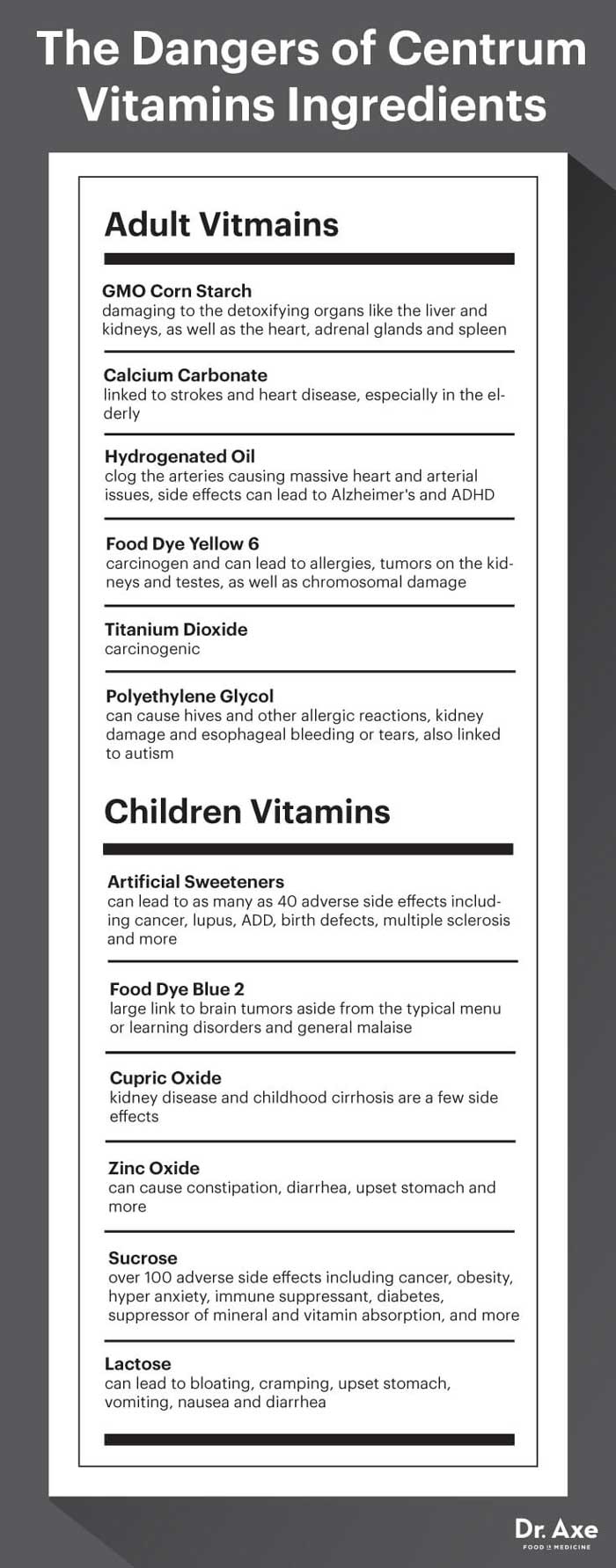This article is shared with permission from our friends at Dr. Axe.
Since the early 1940s, Americans have been taking multivitamin and mineral supplements. Now, more than ever, millions of Americans search for numerous ways to boost their health and immunity. One of the most popular is a daily multivitamin, such as Centrum. Multivitamins account for 40 percent of all supplements purchased. Vitamin purchases totaled $5.7 billion out of the nearly $37 billion in supplement sales in 2014 alone.
The No. 1 selling vitamin, Centrum, is not without contention. Pfizer, the largest pharmaceutical company in the world, is the manufacturer of Centrum, and they are no stranger to controversy.
When Pfzier was threatened by the consumer watchdog group Center for Science in the Public Interest over false claims about Centrum vitamins in 2012, the company settled and was forced to pull claims about breast and colon health but still listed controversial language on its bottles about various health-promoting benefits.
Another concern with the multivitamin market, is its lack of specificity, regulation, and even standards. Multivitamins, “multis,” “MVMs” or “multiples,” as they’re sometimes called, have no set standards or level. The company can blend any various cocktail of supplements and it will be considered a multivitamin.
Centrum Vitamins May Contain Dangerous Substances
Centrum still makes claims about the benefits of taking its multivitamin, from immune boosts to metabolism kicks, yet there are many additives used in these mass-market pills that downright toxic to your body. There are at least three preservatives and color additives, along with various chemicals and additives that may even be toxic to your health in the ingredients of Centrum vitamins.
Centrum Vitamins’ Dangerous Ingredients List
- GMO Corn Starch — The genetically modified version of corn, Bt corn, has numerous negative effects on the body and is specifically damaging to the detoxifying organs like the liver and kidneys, as well as the heart, adrenal glands, and spleen. Hepatorenal Toxicity is a concern with GMO foods, including GMO corn, which causes kidney failure and is typically fatal.
- Calcium Carbonate — While this compound found in rocks, shells, and even pearls is sometimes used to help increase calcium levels in the body; it’s also been linked to strokes and heart disease, especially in the elderly. There have been many recent studies to suggest its link to heart issues and myocardial infarction. It can also negatively interact with medications.
- Hydrogenated Oil — Otherwise typically safe in their natural state, hydrogenated oils quickly turn toxic when processed under extreme heat, atmospheres of pressure and injections of metals. Ingesting these oils clogs the arteries, causing massive heart and arterial issues, as well as producing cholesterol to bandage artery walls that have been impacted. Because of the vascular problems, the brain is often affected, and side effects can lead to Alzheimer’s and ADHD. In some cases, it can only take minutes after ingesting to start impacting your system!
- Food Dye Yellow 6 — This toxic food dye is a carcinogen and can lead to allergies, tumors on the kidneys and testes, as well as chromosomal damage. It can also lead to hyperactivity, restlessness, and even ADHD. The increase in processed snack and fast foods in correlation to the rising number of children on behavioral medications cannot be dismissed.
- Titanium Dioxide — This naturally occurring mineral has recently been found to possibly be carcinogenic to humans. It’s used in many products to increase whiteness, such as paints, ink, paper, and even cosmetics and toothpaste. The FDA has previously listed it as a safe pigment when 99 percent pure. However, in recent studies on rats, exposure to the dust fragments of titanium dioxide caused lung cancer.
- Polyethylene Glycol — This compound is often used in the manufacturing of coal-burning plants, rocket fuel as well as over-the-counter laxatives. This additive can cause hives and other allergic reactions, kidney damage and esophageal bleeding, or tears. It ‘s also been linked to autism. One other side effect, sometimes more common in children, is called encopresis, which is a continuous leakage of semi-formed feces.

Children Centrum Vitamins Are Even Worse
Believe it or not Centrum vitamins for children have even more health hazardous ingredients!
- Artificial Sweeteners (Aspartame) — When you let your child ingest anything with aspartame, you essentially give them a hearty dose of formaldehyde. This carcinogenic sweetener is converted to the toxic chemical, as well as methanol, once digested and can lead to as many as 40 adverse side effects, including cancer, lupus, ADD, birth defects, multiple sclerosis and more.
- Food Dye Blue 2 — You can change the color, but you won’t change the side effects. Food dyes and color additives are some of the most toxic ingredients found throughout the processed food market today, especially for children. This dye, banned in Norway, has a large link to brain tumors aside from the typical menu of learning disorders and general malaise.
- Cupric Oxide — Cupric oxide, a copper mineral, is listed as a hazardous material in Europe. Need more reason to avoid it? It’s also listed as dangerous to the environment and is the reason why we have to go to such great lengths to dispose of batteries. Even worse, kidney disease and childhood cirrhosis are a few side effects to start.
- Zinc Oxide — Also classified as harmful and hazardous in Europe, zinc oxide is what makes the SPF in sunscreens — and why most sunscreens are toxic. It can cause constipation, diarrhea, upset stomach and more.
- Sugar (Sucrose) — Sucrose, the common extraction of cane or beets and more commonly known as table sugar, has over 100 adverse side effects. One that sits at the top of the list is a food source for cancer. Others include obesity, hyper-anxiety, immune suppressant, diabetes, suppressor of mineral and vitamin absorption, and more.
- Lactose (Milk Sugar) — Lactose makes up about 2 percent to 8 percent of the milk by weight. It’s broken down in the stomach by specific enzymes. It’s also what leads to many people to suffer from symptoms of lactose intolerance or unable to digest these lactose sugars. The side effects, or being intolerant to these sugars, can lead to bloating, cramping, upset stomach, vomiting, nausea, and diarrhea.
Vitamins from Real Food & Real Multivitamins
The ideal way to get your daily vitamins and minerals is through the consumption of real foods. Just stock your fridge and pantry with some whole foods that are more easily absorbed and processed by your system first and foremost before rushing to the supplement aisle.
Nutrient-dense foods to consume daily include:
- Vegetables — Start here and never leave. Loaded with vitamins, minerals, and phytonutrients, vegetables should be the most abundant source of vitamins and minerals in your diet each and every day. For every negative side effect of the additives and fillers in mass-market vitamins, there is an opposing, health-promoting benefit in vegetables. Some of the most nutrient-dense vegetables include leafy greens, broccoli, avocados Brussels sprouts, cabbage, sweet potato and watercress. The list of benefits goes on and on, which is why you must eat your veggies daily.
- Herbs — Herbs are the Mighty Mouse of the food world. They’re loaded with nutrients, antioxidants, phytosterols and essential oils that promote health in a small package. Curcumin, found in turmeric, is one of the most powerful antioxidants known to fight against cancer, pain and brain diseases. Volatile oils found in many of the herbs have been used to fight cancers as well as many other ailments. These oils also help in weight loss, deodorizing, anxiety, digestion and more. Some of the most powerful include turmeric, garlic, parsley, basil, ginger and oregano.
- Fruit — Similar to vegetables, fruits contain high amounts of vitamins and antioxidants. They’re a large source of folate, vitamin C, fiber, and potassium. They help lower blood pressure and reduce the risk of heart disease. Many of the “superfoods” around today are fruits. The top five most antioxidant-rich fruits are pomegranate, acai berry, maqui berry, goji berry and red grapes (particularly the skins).
- Sprouted Grains, Nuts, Seeds, and Beans — Sprouting is essentially the practice of germinating seeds — whether grains, nuts, beans or other kinds of seeds — so they’re easier to digest and your body can access their full nutritional profile. A major benefit of sprouting is that it unlocks beneficial enzymes, which make all types of grains, seeds, beans and nuts easier on the digestive system. This also helps increase beneficial flora levels in the gut, so you experience less of an autoimmune type of reaction when you eat these foods.
- Organic, Grass-Fed Meat and Wild Game — Omega-3 fatty acids are essential for the body as healthy fats, and organic, grass-fed meats have high amounts of them — in fact, two to four times as much as grain-fed meat. Grass-fed meats and wild game are typically richer in nutrients but lower in fat and calories. Grass-fed meats are also rich in CLA, another healthy fat that battles cancer, as well as vitamin E.
- Free-Range Poultry and Eggs — Similar to grass-fed meats, free-range poultry, and eggs contain much more nutrients and good fats than the commercial, caged variety. They contain more beta-carotene, vitamin E, and A, as well as omega’s, all while having a third of the cholesterol and a quarter of the saturated fat. Free range eggs are also one of the few foods that contain vitamin D.
- Wild-Caught Fish — Wild-caught fish are much better for you and provide essential fatty acids without the increased levels of hormones, colorings and potential toxins found in many farmed fish. Wild-caught fish provide an excellent source of protein as well, and when eaten at least twice a week, they can help reduce the risk of Alzheimer’s and other diseases.
- Pastured Raw Dairy — Raw dairy vastly outweighs pasteurized dairy and can help your body in many ways. Not only does it come loaded with fat-soluble vitamins, minerals, and acids, but it also boosts the immune system; can help with skin, nails and hair; and helps fight cancer as well as many digestive disorders.
Choosing Truly Healthy Vitamins
A diet can sometimes fall short, so if you do take a vitamin, make it a real food multivitamin.
- Do’s: 100 percent organic and 100 percent whole food-based, either raw or low-temperature heated. Also make sure the vitamin contains minerals, which are key to vitamin absorption.
- Dont’s: The label should not read any soy, gluten, corn, hydrogenated oils, preservatives, GMOs, colorings or dyes, or binders like magnesium stearate. You also don’t want any USP-verified vitamins, which might sound good but contain synthetics.
Final Thoughts on Centrum Vitamins
It’s so important to read the labels of everything you buy. Unfortunately, not every supplement is actually “healthy,” particularly these Centrum vitamins.
Large pharmaceutical companies like Pfizer have actually created multivitamins. When you consider your daily intake of vitamins and minerals, it’s essential to base your intake off of whole foods. Your body will certainly thank you for many years to come!
If you know someone who might like this, please click “Share!”


